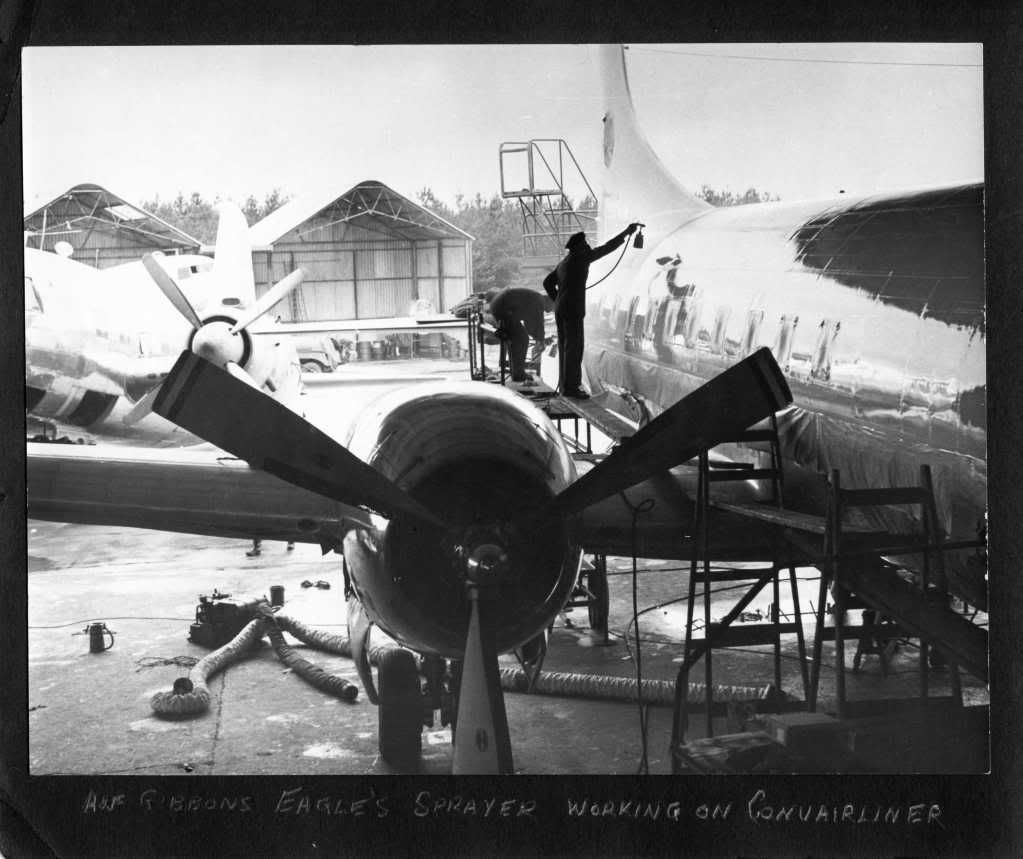Post by flyboy on Jun 26, 2018 20:37:51 GMT
Convair Liners Civil and Military:
Existing as an aerospace company from 1943 to 1994 Convair were at first unofficially, then officially know as Convair following the merger of The Consolidated Aircraft Company and the Vultee Aircraft Company. This produced a huge aircraft company ranked fourth overall in the United States market, mainly due to outstanding wartime contracts, ahead of producers such as Douglas,Boeing and Lockheed.
American Airlines wanted a DC-3 replacement and initially placed an order for the Convair 110, which first flew on July 8th 1946, but found it to be too small for their requirements and asked for a larger version. This was provided in the form of the Convair 240. Featuring cabin pressurization it soon became established as a viable commercial airliner and over a long development period this resulted in various civil and military variants.With a first flight on March 16th 1947 and entering service in June 1948 the Convair 240 was to prove to be one of the most advanced short haul airliners of it's day.
The success of the Convair 240 led to a 1.37m (4ft 6in) extension of it's cabin length and this variant was designated the Convair 340 which first flew on October 5th 1951. There was an option to incorporate weather radar in this model which resulted in an easily recognisable elongated nose extension.
An improved version, the Convair 440 Metropolitan incorporated much improved sound proofing, streamlined engine cowlings and rectangular exhaust outlets plus the extended radar nose which was now standard on this model.
All three models sold in large numbers to airlines especially in North America where they formed the backbone to the short and medium haul fleets.
Military sales also saw the types in service with the US Air Force as the C-131 and T-29 and the US Navy where it was designated the R4Y.
Many of the originally piston powered versions of the airliner, having proved their robustness and reliability over the years were converted to turboprop power and given a new lease of life. As early as 1950 some piston powered Convair 240's were being converted to turboprop Convair 240-21 Turboliners, while a YC-131C prototype turboprop version was developed for proposed use by the US Air Force .
One other version of note was the 1954 conversion by D.Napier and Sons in Britain who converted six aircraft with their 3060hp (2280kW) Eland N.El.1 turboprop engines to be known as the 540. G-ANVP the prototype of this aircraft routed through Blackbushe in June 1957 en route to the Paris Air Show.
Variants:
Model 110 Unpressurized prototype with 30 seats. One built.
240 Initial production version.
240-21 Turboliner. Allison T38 turboprop engines.
300 Conversion from 240 with engines and nacelles as used in 340.
340 Better performance than the 240, lengthened with an additional 4 passenger capacity.
440 Metropolitan, improved sound proofing + optional weather radar, up to 52 passengers.
540 Turboprop converted 340, Napier Eland engines,6to Allegheny,12 new builds by >
--..-- Canadair for Royal Canadian Air Force as CC-109s'.
580 Conversion from earlier models with four bladed Allison engines, plus enlarged fin.
580 Airtanker for fire-fighting with retardant tanks and dropping system.
600 Conversion from 240 with 2x Rolls-Royce Dart turboprop engines.
640 Conversion from 340 or 440 with four bladed propellers and 2x turboprop Dart engines.
5800 A US Navy C-131F Samaritan stretched by 16ft 7in with a freight door, Allison engines >
and uprated avionics with EFIS.
580S Allison Turbine ATF 580S Turbo Flagship. A stretched Convair Liner conversion.
Military Models
C-131 Samaritan, 240, 340 & 440 models used by USAF on medical and VIP duties.
T-29 Trainer model of the C-131 used to instruct navigators and radio operators.
R4Y Samaritan, used by US Navy under this designation.
CC-109 Cosmopolitan, Canadian conversion, Napier Eland turboprop engines. In Canadian >
Armed Forces use. All re-engined in 1966 with Allison engines.
CL-66 Canadair company designation for the CC-109 Eland powered variant.
Civilian Operators
There were a great number of operators of most variants of the aircraft world wide >
with over eighty in the United States and Canada alone.
Specification Convair 240:
Crew 2or3 flight deck crew.
Capacity 40.
Length 74ft 8in (22.76m).
Wingspan 91ft 9in (27.97m).
Height 26ft 11in (8.20m).
Wing Area 817sq ft (75.9sq m).
Weight Empty 25,445lb (11,542kg) (revised 29,500lb, 13,381kg).
Gross Weight 40,500lb (18,370kg) (revised 42,500lb, 19,278kg).
Fuel Capacity 1000 US Gal (3785 lt) to 1,550 US Gal (5867 lt).
Powerplants 2x Pratt & Whitney R-2800-CA3 Double Wasp air cooled radial engines >
2,400hp (1,800kw) each.
Propellers 3 bladed Hamilton Standard or Curtiss.
Speed Maximum 315mph (507km/h,274kn).
Cruise Speed 280mph (451km/h,243kn) maximum.
Range 1,200mi (1,043nmi, 1931km).
Service Ceiling 16,000ft (4,900m).
Rate of Climb 1,520ft/min (7.7m/s).
Recorded Visitors:
Reg Type c/n Operator Information Sqn Dates Noted.
140993 R4Y-1 276 US Navy FASRON 200 4.8.58,31.8.58,2.9.58,29.12.58. 
141020 R4Y-1 303 } --..-- ex NATC Patuxent River { 30.3.59-31.3.59>
--..-- --..-- --..--} --..-- CinC Forces Southern Europe { 3.7.59-4.7.59,29.8.59-30.8.59>
--..-- --..-- --..--} --..-- --..-- { 7.9.59-11.9.59,16.10.59.
141021 --..-- 304 ] --..-- FASRON 200 [ 10.1.59,30.3.59,4.4.59,9.4.59>
--..-- --..-- --..--] --..-- --..-- [ 2.8.59-3.8.59,14.8.59,16.8.59>
--..-- --..-- --..--] --..-- --..-- [ 23.8.59,26.8.59,29.8.59,>
--..-- --..-- --..--] --..-- --..-- [ 6.9.59,13.10.59,8.5.60.
145963 R4Y-2 482 } --..-- Anacostia on detachment to Naples { 8.10.58,10.10.58,>
--..-- --..-- --..--} --..-- --..-- {20.2.59-21.2.59.






